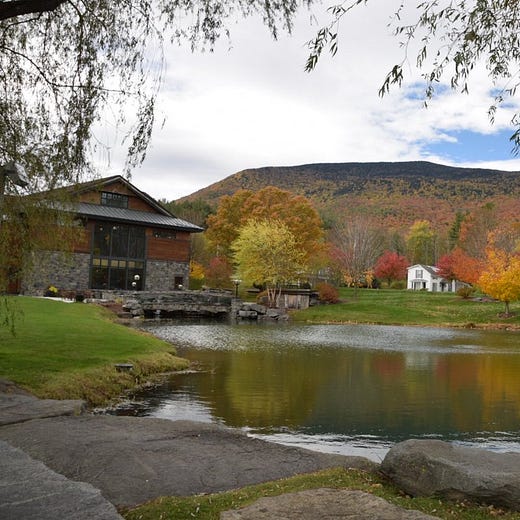Shaking The Tree
Notes from The Lab: Miners and how their capitulation effects price
Ah, the magic of early autumn air.
At no other time is the shift in nature’s temperament so obvious.
One day it’s a summer scorcher, the next it’s a crisp cool fall morning.
Despite the fact that we know of its annual timing, the fall always seems to arrive unexpectedly. Greeting us with the warmth of an old familiar friend not seen in some time, and the nostalgia of a forgotten favorite song at long last replayed.
Sunlight goes from relentlessly beating down for 16 hours a day, to short bursts of gold that quickly fade away.
The leaves change like a stoplight, from dark green to bright red, and remind us to rest and reflect on the experiences of yet another year gone by too soon.
If you’re here for alpha and this ode to autumn has you confused, allow me to explain….
Camping may seem like an odd hobby for a digital janitor, but did just that in Vermont last month. While there I spent time studying not only books, but also the greatest teacher of all, nature.
This experience led me to recognizing interesting similarities between the changing of seasons and the effect crypto winter is having on distressed Bitcoin miners and market prices which we’ll discuss today.
What I learned about specifically are two different forms of trees, “evergreen” and “deciduous”.
Surprisingly they have more in common with BTC miners than you may think.
You’re likely familiar with evergreens. They’re the ones most commonly used as Christmas trees. They get their name because their colors never change. Regardless of season, these trees’ leaves are consistent.
As it relates to Bitcoin you can think of the evergreens as responsible, well researched, and forward planning miners.
Much like the evergreens, these miners plan ahead year round, conserve resources, and equip themselves to survive through the dead of winter. And though they never get as vibrant as their deciduous counterparts they never fade away either.
Through the highs and the lows, the hot and the cold, evergreen leaves will be there.
Deciduous trees on the other hand are the ones whose leaves shine brightest in the warmth, but die the fastest in the cold.
You can think of under prepared and over-leveraged miners as leaves on a deciduous tree.
These are the ones who go all in when prices are soaring in the hopes of getting rich quick.
Rather than conserving, they spend their resources in the spring and summer months when sunshine is plentiful and growth is easy, and fail to anticipate replenishment issues.
This is because when their host trees are resource rich (just as BTC’s network is for miners during a bull run) they don’t mind sharing life with the fast growing leaves for a time.
Inevitably though the cold hits, resources become scarce, and deciduous leaves lose their access to the host tree’s nutrients. These once bright and ambitious leaves starve off then fade away.
Not unlike ill equipped miners who become unprofitable then bankrupt during crypto winters.
Despite this happening as part of a yearly cycle, deciduous leaves never learn their lesson. They always seem to think that somehow they’ll outgrow the death of winter’s frost.
To get a deeper understanding of what exactly it is I’m explaining here let’s pair what I learned from observing the leaves with what I learned from observing mining data.
“When one tugs at a single thing in nature, he finds it attached to the rest of the world.”
-John Muir
High on Hash
Hash rate measures the total amount of computational power being summoned to process transactions and power Bitcoin’s network at a given time.
As we can see below it’s been in a relentless macro uptrend since 2016, rising from less than 2 EH/s to nearly 280 EH/s at present.
A stunning 140x+ increase in net compute power in just 6 years.
This hash rate is contributed by miners, who are individuals and entities collectively applying their decentralized computational power to validate transactions on Bitcoin’s ledger and secure the network.
In exchange for doing so they are compensated with BTC.
The higher the hash rate the more robust and desirable the blockchain becomes for users and investors.
Conversely, the higher the hash rate the harder it becomes for miners to earn BTC.
High hash rates require miners to spend more on energy costs in order to receive fewer BTC rewards.
This can be observed here in the rise of mining difficulty:
Difficulty is less of an issue when the price of BTC is high because profits offset costs, but since BTC has been regularly trading sub $20,000 since June, difficulty has become a major pressure point on inefficient mining operations.
This stress can be visualized by taking a look at miner revenues below, which have declined by over 65% since late last year.
Add to this skyrocketing costs of energy due to the global inflationary crisis, and it’s no wonder over-leveraged miners are on the brink of total annihilation.
Evergreen vs Deciduous
The evergreen Bitcoin miners mentioned earlier were prepared for this.
They studied and observed economic market cycles, took profits when times were good, and stored up summer resources in order to survive this harsh winter of high costs and low income.
The deciduous miners by contrast have been taken almost entirely by surprise. The possibility of high difficulty, high energy costs, and low BTC price had never crossed their minds up until the point that all 3 happened all at once.
What can go wrong, will go wrong.
The result? Once the market changed seasons deciduous miners were quick to fade from green to red just like leaves in autumn.
Here’s some headlines from the past month alone:
Core Scientific, the world's largest Bitcoin miner (~4% of the hash rate), announced it won't make payments due this month, and will likely claim bankruptcy by December.
Compute North filed for bankruptcy.
Despite selling over $100mm of equity last month, Iris Energy has announced they are nearing default on over $100mm loaned to them by NYDIG.
Argo Blockchain announced they will need to curtail or cease operations if unable to access further financing.
China-based miner, Poolin, cut their hash rate by over 50% and froze withdrawals.
Compass Mining shut down their operations in Georgia.
Currently zombie companies like Core Scientific are net negatives for Bitcoin. They no longer hold any BTC, yet their scramble for cash flow solutions leads to them suppressing the price nonetheless. On a daily basis they sell freshly mined coins and extract millions of dollars in value from the network.
In exchange Bitcoin receives only their addition to hash rate (which is no longer needed), and FUD inducing press coverage.
Worse yet, the size of their mining operations are so large that it raises the difficulty levels for all other miners and decreases their revenues by proxy.
We see this in the data.
At present the average energy cost required by miners to produce 1 BTC hovers around $17,000 depending on specific energy, capital, and operational expenses.
This shrinking profit margin means miners who weren’t well capitalized heading into the bear market are now being forced to sell their freshly mined supply ASAP despite price being down over 70% from ATH.
The chart below shows the USD amount of BTC sent to exchanges by miners over the past 3 months.
We can see a steady flow of ~$20mm in BTC sell pressure has been sent to exchanges daily since June as distressed miners struggle to remain solvent.
The 3 largest spikes above show single day exchange inflows of:
$100mm+ July 28th
$63mm+ October 12th
$46mm+ October 19th
This persistent pressure placed on the market by deciduous miners has been a major contributor to BTC’s year-long downtrend.
Because of their ability to generate and instantly sell large amounts of BTC daily it will be difficult for the market to sustain any rallies until they are fully purged.
Which leads us to the elephant in the room, what will happen to Bitcoin’s price when these failed miners finally do capitulate out?
Seasons Change
The silver lining to all this chaos is that BTC has absorbed the past 4+ months of increased miner selling remarkably well considering the macro environment.
The fact that it hasn’t broken to the downside of June lows alone is reason for optimism.
In addition to that, at present miners own less than 1.75 million BTC in aggregated reserves.
This is the lowest amount they’ve held since early 2010, when the price of BTC was less than $1.
Of the remaining 1.75mm BTC, over 90% of it is believed to be permanently lost as it hasn’t moved in over 7 years. Lost or otherwise inaccessible coins are not a threat to move price down further.
This data implies that most, if not all, miners capable of being squeezed out of their BTC supply have already capitulated.
Add to this the persistent rise in hash rate, which implies that market Darwinism is taking place and that fragile miners are being actively replaced by robust ones, and macro-oriented Bitcoin bulls should start to feel their conviction rising.
Now it’s just a matter of BTC shaking the remaining dead leaves off its branches.
At minimum we should expect to see a ~10% drop in hash rate over the coming months as deciduous miners begin to unplug and fall away. One thing to be especially mindful of is that if this drop happens in a sudden or drastic way it could wreak havoc on price in the near term due to knee-jerk perceptions. Headlines charged with fear, uncertainty, and doubt are likely to reach heightened levels at that time.
But after this exodus, deciduous revenues will begin to flowing back to Bitcoin’s faithful stewards, the evergreens, who are now providing the market with a strong foundation upon which to build its future recovery.
Under most circumstances large drops in hash and difficulty rates would be a bearish development, but here it seems that could be a welcomed relief, even if it comes at the cost of short term price volatility.
Until that hash rate washout manifests and the daily miner sell pressure subsides, all we can do is wait patiently for spring to come and relieve us from yet another brutal crypto winter.
What do you guys think? Comment below or message me on Twitter @JLabsJanitor
Your friend,
JJ
“You expected to be sad in the fall. Part of you died each year when the leaves fell from the trees and their branches were bare against the wind and the cold, wintery light. But you knew there would always be the spring, as you knew the river would flow again after it was frozen.” -Ernest Hemmingway











This is really helpful, thank you for the post. If average cost to mine 1 BTC is $17k, what is the long-term case for evergreen miners? They are barely squeaking out a profit now, energy costs are likely to go up, miner block rewards get halved in 2024...it seems that the long-term microeconomics of the miners aren't favorable? Their only saving grace is if BTC price doubles or more every 4 years, which could happen...but if that doesn't happen, and price increases don't outweigh the halving and the increasing energy costs, is there anything stopping a negative feedback loop where miners stop mining b/c there is no economic incentive to mine? And if mining stops being profitable, then what?
Thank you. That's the context I was looking for. As such, a really helpful write up.
I skipped most of the flourish to be honest. Not because it isn't well written. But because my mind refuses to be cluttered by more metaphors and things that are not "the thing".